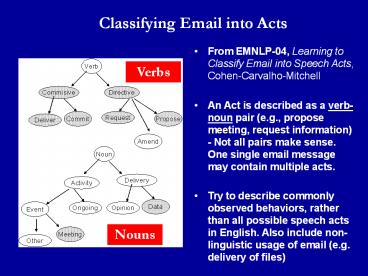Classifying Email into Acts - PowerPoint PPT Presentation
Title:
Classifying Email into Acts
Description:
... 04, Learning to Classify Email into Speech Acts, Cohen ... in will try to keep -numbex i will. i will try to. i will check my. I do not have. meet at horex pm ... – PowerPoint PPT presentation
Number of Views:31
Avg rating:3.0/5.0
Title: Classifying Email into Acts
1
Classifying Email into Acts
- From EMNLP-04, Learning to Classify Email into
Speech Acts, Cohen-Carvalho-Mitchell - An Act is described as a verb-noun pair (e.g.,
propose meeting, request information) - Not all
pairs make sense. One single email message may
contain multiple acts. - Try to describe commonly observed behaviors,
rather than all possible speech acts in English.
Also include non-linguistic usage of email (e.g.
delivery of files)
Verbs
Nouns
2
Some Improvements
- With more labeled data (1743 msgs), using
1g2g3g4g5g features - Using careful (and act specific) pre-processing
of message text - Using act specific feature selection scheme (Info
Gain, ChiSquare, etc) - - Significant performance improvements.
3
Some Examples of 4-grams
is fine with mmee is good for mmee i will be
there i will look for will look for pppeople i
will see pppeople as soon as I numbex per
person i will bring copies our meeting on dday is
ok for mmee look for pppeople in will try to
keep -numbex i will i will try to i will check
my I do not have
meet at horex pm horex pm on ddday on ddday at
horex pppeople meet at horex to meet at
horex would like to meet please let mmee
know ddday at horex am ddday at horex pm lets
plan to meet would pppeople like to pppeople will
see pppeople is fine with mmee numbex-numbex
pm can pppeople meet at ddday numbex/numbex is
good for mmee
and let mmee know know what pppeople think would
be able to do pppeople want to do pppeople need
to do not want to pppeople need to get please let
mmee know pppeople think pppeople need mmee know
what pppeople what do pppeople think pppeople be
able to pppeople don not want pppeople would be
able that would be great Call mmee at home
Meeting (noun)
Request
Commit
Req
4
Results
5
Results
6
Collective Classification Predicting Acts from
Surrounding Acts
7
Content versus Context
- Content Bag of Words features only (using only
1g features) - Context Parent and Child Features only ( table
below) - 8 MaxEnt classifiers, trained on 3F2 and tested
on 1F3 team dataset - Only 1st child message was considered (vast
majority more than 95)
Request
Request
Proposal
???
Delivery
Commit
Parent message
Child message
Parent Boolean Features Child Boolean Features
Parent_Request, Parent_Deliver, Parent_Commit, Parent_Propose, Parent_Directive, Parent_Commissive Parent_Meeting, Parent_dData Child_Request, Child_Deliver, Child_Commit, Child_Propose, Child_Directive, Child_Commissive, Child_Meeting, Child_dData
Kappa Values on 1F3 using Relational (Context)
features and Textual (Content) features.
Set of Context Features (Relational)
8
Collective Classification Model
Commit
Other acts
Request
Deliver
Current Msg
Parent Message
Child Message
9
Collective Classification algorithm (based on
Dependency Networks Model)
New inferences are accepted only if confidence is
above the Confidence Threshold. This Threshold
decreases linearly with iteration, and makes the
algorithm works as a temperature sensitive
variation of Gibbs sampling after iteration 50,
the threshold is 50 and then a pure Gibbs
sampling takes place
10
Collective Classification Results
11
Act by Act Comparative Results
Kappa values with and without collective
classification, averaged over the four test sets
in the leave-one-team out experiment.
12
What goes next?
- Extend Collective classification by using the new
SpeechAct classifiers (1g-5g, feat selection) - Online(incremental) and semi-supervised learning
CALO focus. - Integration of new Speech Act package to
Minorthird Iris/Calo. - Role discovery network-like features speech
act































